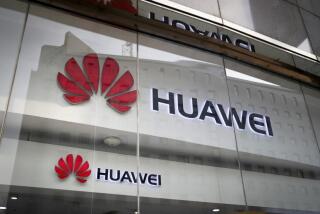South Korea Ready to Enter Flat-Panel Race : Electronics: New factories are expected to help two firms crack the Japanese-dominated field.
- Share via
KIHEUNG, South Korea — Right now, they’re mere skeletons of buildings.
But when the factories they will house start operating early next year, South Korea’s electronics manufacturers say they will have cracked another industry dominated by Japan: flat-panel computer screens.
“A great future lies ahead for Korean manufacturers in this field,” said Park Yong-bok of the Ministry of Trade, Industry and Energy. “This is certainly the biggest market available for us since the semiconductor boom.”
In April, South Korea moved to offer flat-panel manufacturers a host of incentives including research funds, tariff reductions for importing equipment, and easier access to land for factories.
At least two South Korean electronics producers--Samsung and Goldstar--say that in 1995 they will begin mass production of these advanced screens, called thin film transistor-liquid crystal displays, or TFT-LCDs.
The panels take the place of cathode-ray tubes in notebook computers and portable televisions.
They offer vivid color images on a screen less than an inch thick.
In a factory being built at an existing semiconductor complex amid the green hills of this town outside Seoul, Samsung Electronics plans to churn out 60,000 TFT panels a month beginning in March.
Goldstar Co. plans to start producing 50,000 screens a month next May, on a $375-million production line being built in its Kumi electronics complex in central South Korea.
The location of these plants highlights South Korea’s strategy of entering new markets by pairing research with technology where it enjoys a comparative advantage. South Korea hopes to repeat its success with computer memory chips--another business that used to be dominated by Japan.
South Korean firms today provide about a quarter of the world’s dynamic random access memory, or DRAM, chips. Samsung is the world’s biggest supplier. TFT-screen manufacturing employs technologies and production processes similar to those used for memory chips. It is also a business well-suited to South Korea’s big electronics producers, which can afford huge investments and have the technical resources needed for mass manufacturing.
“We will have little difficulty in finding markets for our products. We do not expect TFT supply to catch up with demand until 1997,” said Kim Sang-soo, a chief researcher at Samsung’s LCD division.
The United States has also recognized the potential marketplace for flat screens. Earlier this year, the Defense Department initiated a grant program to encourage U.S. manufacturers.
Just this week, IBM and Toshiba said they would soon double production of flat screens at a plant they jointly own in Japan to 200,000 a month.
Output in Samsung’s Kiheung plant is forecast to reach 100,000 screens a month by late 1996. The company is planning a second plant in 1996, expanding its total TFT investments to $625 million by 1998.
Samsung is now producing 3,000 nine- and 10-inch TFT screens a month at a pilot line used for U.S. clients such as Texas Instruments Inc. It says its screens consume less electricity and offer more vivid images than those made in Japan.
Goldstar plans to have invested $800 million by 1997, when its monthly capacity will be expanded to 100,000 panels. The company hopes to generate $600 million in annual TFT sales by the year 2000.
Hyundai Electronics, another success story in the semiconductor industry, is negotiating to install a TFT-production line in its Ichon complex.
In early June, Orion Electronics launched a production line, bought from Toshiba, to produce less advanced screens for color and monochrome notebooks, as well as wristwatches and calculators.
Eventually, South Korean firms will end up competing with the Japanese manufacturers that control 90% of the LCD market, worth $6 billion annually and growing at 30% a year.
With the rise of laptop computers, flat-panel screens have become critical to the computer industry and the military, in airplane cockpits and war room displays. In the future, they will make possible large, wall-mounted TVs only a few inches thick.
“LCDs are not a matter of choice. It is almost inevitable for South Korean electronics companies to enter the business,” Samsung’s Kim said.
More to Read
Inside the business of entertainment
The Wide Shot brings you news, analysis and insights on everything from streaming wars to production — and what it all means for the future.
You may occasionally receive promotional content from the Los Angeles Times.









